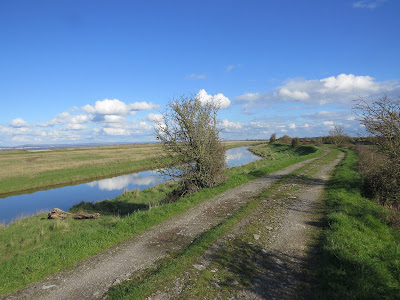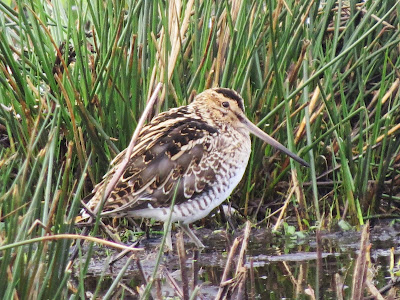How on earth did this young naturalist-about-town born on April Fools Day 1964 (in the afternoon so it doesn't count), become a sexagenarian blogger. I began this blog in 2007, which made me 43 years of age, gulp was I really that young? Some of my school friends who I still keep in regular touch with were talking over the weekend about our time in junior school when we took part in a project - how old will we be in the year 2000 and what will the world be like? I can vaguely remember being part of this, the usual weirdness, we'd all be living in sealed bubbles or driving aero-cars, or have turned green and communicate with telepathy, but I can distinctly remember thinking, gosh I'll be 35 years old on January 1st 2000 and then 36 on my birthday. That age seemed very very old to a seven or eight year old. Yet now the year 2000 is itself 24 years ago.
However as I nudged into my three score years on Easter Monday, I enjoyed the fact that my significant birthday coincided with Easter, and rain. For a change then on this blog a brief resume to remind myself of this moment in the years to come, while sitting by the fire in my slippers. Though why there's a fire in my slippers is anyone's guess.
Good Friday. We set off on a shortish (7 mile) walk along the Strawberry Line from the nearby village of Winscombe to Cheddar Reservoir and back. This occurred after being rudely awakened by the jackdaws making a nest in the roof above the bed. We've had sparrows and starlings roosting in this part of the house for as long as I've lived here. The house was only built in 1997, but I think being the former show home it was thrown up rather than built, I've had to rectify some quite strange things over the years, such as a window installed the wrong way around, and a strange electrical supply that had no obvious source.
The hole in the roof is where some flashing has come away, luckily it doesn't let the rain in, but the cavity behind the hole is of a fair size and sealed off from the loft. In past winters I'd hear starlings doing what sounded like a sand-dance as they shuffled about in there to keep warm. However about a week or so ago I heard an almighty clattering and banging coming from above the ceiling, accompanied by the tell tale jak-a-jak call of jackdaws. At first I thought it was coming from outside but when I heard what sounded like a small forest being dropped onto the floor over the following days I knew what was going on. Some acquaintances have suggested calling pest control.. really? Okay there'll be a mess in the roof space, but I feel very lucky to have this brilliantly intelligent bird choosing to live with me. Though I have to admit gingernut our cat is a little perplexed by the racket. As I type this the nest building has ended, replaced this morning with some lovely soft contact calls from the pair. Eggs soon I think.
Our walk was along the old railway line that once ran from Shepton Mallet to Clevedon, carrying goods and the product it became famous for, and from which the Sustrans managed pathway now gets its name, Cheddar strawberries. I've heard tell of the 'strawberry' trains running all day, in the season, filling the air with a fruity scent as they whisked these strawberries away from the Mendip slopes to London and Midlands markets. All of this ended with the Beeching cuts but over the last few decades more and more of the old railway route has been restored and opened up to walkers and cyclists, plus it is a fantastic nature reserve in its own right. We'd just set off when there was the most impressive hail storm, turning to rain. There was no shelter so we just pushed on into the wind trying to cover the half a mile or so to the Shute Shelve Tunnel as quickly as possible and out of the rain. This tunnel is a magnet for bats with many studies conducted here throughout the year. We however reached the southern end of the tunnel to be greeted with sun. So odd entering in rain and exiting in sunshine.
Fortunately the rest of the walk was predominantly dry and with the sun up, the wildlife along the path sides as we walked was an added incentive. Violets (violet and white flowers) and primrose were everywhere, a few early bluebell, arum poking up, alexanders were growing tall, even a patch of wild garlic had a few white flowerheads visible. Catkins adorned hazel and willow and the leaf burst was in full swing along the path, though the standing trees were still winter-bound. Chiffchaffs were everywhere, robin, chaffinch, blackbird, long tailed tit, wren and dunnock all flitted in front of us. Butterfly singles of brimstone, peacock and speckled wood added to the mix with a couple of small white too. Overhead a couple of buzzards wafted by, and a kestrel, and in the fields a smattering of corvids and gulls mingled with sheep. I'd hoped when we reached the reservoir I could do some birdwatching as it is a well known site for waterfowl. However the wind had really picked up and while there was the usual coot, great crested grebe, mallard and tufted duck on the water with pied wagtail and meadow pipit on the banks, nothing else really was obvious other than a green woodpecker which flew to a fence post and clung on there giving remarkable views. We got back to the car after about three hours, including a coffee in a café, just as the heavens opened once again.
Saturday we were at home and pottered in the garden. The spring flowers are looking brilliant here at the moment, newly emerged, fresh and nothing much yet has succumbed to decay, it is a lovely time of year. The sun is warm too and I watched a dark edged bee-fly buzzing the daffodils and pulmonaria for ages. We've had these in the garden for a couple of years now, I love them, they're really funky. Sadly a peacock butterfly had died in the greenhouse overnight, but outside and very much alive was a brimstone and a small white. There were hoverflies and solitary bees everywhere too. As we pottered in the garden a pair of raven cronked their presence overhead, these are a regular sighting now.
Easter Sunday saw us walk a different six mile section of the Strawberry Line, this time from Congresbury to the new EDF sub-station on Nye Lane. Part of the planning approval for this feeder station from Hinkley Point, was to create a new permissive link between two parts of the existing Strawberry Line, each part of which ended at a farm who refused public access. And very impressive it is too. But not as impressive as I realised a raven pair were nest building in one of the huge super-structures carrying the electricity into the sub-station.
I'd heard a cronk as we looked over the new site and saw a raven flying by carrying a sizeable twig. I wondered where it was going before it flew left at an angle, back on itself and into this gantry style metal structure. As it arrived, from inside the structure, a softer cronk-craw could be heard - its mate. One of the birds then flew out, did a Biggles style wing roll and disappeared into an orchard over the lane, only to then reappear a minute or so later with another twig, this time flying directly to and into the gantry. Raven nests are huge so this may well fill the void in that latticework metal gantry, but it will be well hidden and protected. I'll have to pop back and have a proper look, but it seemed incongruous that this bird which extols wild places should decide to make its home in an ultra-modern electricity sub-station now hissing and fizzing with electricity from a nuclear reactor. And given there is a 3 meter electrified fence around the site, I should think the raven are quite safe in there.
I also noticed that the outer fence, (thankfully not live wired), has badger holes cut into it wherever a badger track existed in the undergrowth. Someone has taken a lot of effort into wildlife mitigation and with a lot of tree planting on the site, and a large pond newly dug, it should mature nicely. On the route to and from Congresbury yet again the birdlife was astonishing, the same species as on Friday but with the addition of song thrush, bullfinch, greenfinch, goldfinch, Cettis warbler, little egret and a yaffling woodpecker. There are also a lot of badger tunnels along this path. We also startled a fox while trying to help an elderly couple retrieve their 'lost' dog who was running about a distant field - thankfully after half an hour Memphis the dog returned safe and well and looked very happy, as did his owner.
Easter Monday and the birthday had arrived. For a few weeks now I'd said I'd like to visit Elworthy Cottage Plants on my birthday as while normally visiting is by appointment only, it was to open on April the 1st under the yellow-book National Garden Scheme. I'd recently been reading about this small specialist nursery, about an hours drive from home nestled in the Brendon Hills and thought it was worth a visit as I'd never been before. It is located in the middle of a lovely quiet part of Somerset betwixt the Quantocks and Exmoor complete with evocative wild-sounding west country villages such as Monksilver, Roadwater, Timberscombe, Higher Vexford and Wheddon Cross. We drove through torrential rain to get here and as soon as we arrived I thought, I've been here before. When exactly I'd been there before I can't remember but it was, like on this visit, with Mrs Wessex-Reiver. Oh well we're here now so best have a cup of tea and some cake.
As we consumed the tea and cake the clouds parted and for our entire visit the sun shone. Its quite a difficult place to find so there were only a handful of people here, in fact more people helping the owners than visitors I'd say. And on this April day it looked stunning, drifts of snake-head fritillary, daffodils still in their prime, wood anemones, hellebores, primrose and a host of pulmonaria. The owner is known also for her collection of snowdrops, of which there were hundreds of clumps round the garden, not in flower of course. I chatted to her husband asking at some point if they had Galanthus 'fly fishing' - they do but not for sale this year, though the suggestion was if I email them in the autumn then they may know if they can sell me one next spring. It is a difficult cultivar to source so I'm very happy to wait. After an hour mooching around in this lovely garden we headed back home, yet again in torrential rain, stopping on the way at Hodder's Combe to look at the rookery there and half an hour tree-bathing.
All in all then an enjoyable way to shuffle into year sixty. We mostly managed to avoid the deluges and found ourselves immersed in some lovely wildlife encounters. Speaking of which I must go and see what those jackdaws are up to.























































